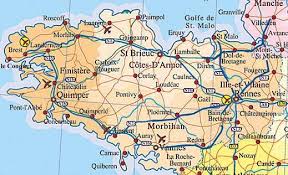Gavrinis
Brittany *
Brittany in northwestern France is sometimes referred to as Little or Lesser Britain. It is one of the most exciting regions of Megalithic Europe. The stone rows of Carnac are unequalled, Le Grand Menhir Brisé was once the largest standing stone in Europe, while  Morbihan contains a huge number of dolmens and standing stones.2019 saw a report that “Bettina Schulz Paulsson, an archaeologist at the University of Gothenburg, reexamined some 2,410 radiocarbon dating results that have been assigned to Europe’s megaliths and put them through a Bayesian statistical analysis. Based on the picture the data presents, Schulz Paulsson believes that the megaliths were first constructed by dwellers of northwest France during the second half of the fifth millennium BC.” (b) Both Robert Hensey, who has studied and written about Newgrange [1766.6] and Mike Parker Pearson, Stonehenge’s leading, authority, have endorsed this idea of a French origin for megalith building(c).
Morbihan contains a huge number of dolmens and standing stones.2019 saw a report that “Bettina Schulz Paulsson, an archaeologist at the University of Gothenburg, reexamined some 2,410 radiocarbon dating results that have been assigned to Europe’s megaliths and put them through a Bayesian statistical analysis. Based on the picture the data presents, Schulz Paulsson believes that the megaliths were first constructed by dwellers of northwest France during the second half of the fifth millennium BC.” (b) Both Robert Hensey, who has studied and written about Newgrange [1766.6] and Mike Parker Pearson, Stonehenge’s leading, authority, have endorsed this idea of a French origin for megalith building(c).
The earliest suggestion that Atlantis may have been connected with the Armorican peninsula came from François Gidon in the 1930s when he proposed that Atlantis had been situated on an exposed Celtic Shelf stretching from Brittany to Ireland. Unfortunately, he dates the submergence of this land to between 3000 and 1200 BC, which was millennia after that part of the Celtic Shelf had been inundated by the Flandrian Transgression.
Jean Markle was convinced that the Carnac stones were connected with Atlantis. Recently, Sylvain Tristan followed the work of Jean Deruelle in supporting a megalithic Atlantis. Further support has come from Alfred deGrazia and Helmut Tributsch who saw Megalithic Europe as Atlantis with the island of Gavrinis in Brittany as its capital.
The American researcher, Hank Harrison, considers the Morbihan départment as a significant Atlantean location if not the home of its capital.
Reinoud deJonge proposes even greater significance for the Brittany megaliths with his claim that they record the Flood of Noah in 2344 BC(a).
A fairly lengthy illustrated paper regarding ancient catastrophes in Brittany is available online(d).
(a) See: Archive 2501
Tributsch, Helmut *
Helmut Tributsch (1943- ) was born in a small German-speaking enclave in Fruili in North East Italy. He was a Professor of Physical  Chemistry from 1982 at the Free University of Berlin until his retirement in 2008. When his birthplace was destroyed in 1976 by an earthquake he began a study of animal behaviour prior to such events and their role as earthquake predictors, leading to the publication of Wenn die Schlangen erwachen (When the Snakes Awaken) in 1978.
Chemistry from 1982 at the Free University of Berlin until his retirement in 2008. When his birthplace was destroyed in 1976 by an earthquake he began a study of animal behaviour prior to such events and their role as earthquake predictors, leading to the publication of Wenn die Schlangen erwachen (When the Snakes Awaken) in 1978.
His interests also extended to include Atlantis, regarding which, he published Die Gläsernen Türme von Atlantis[718] (The Glass Towers of Atlantis) in 1986. His view was that megalithic Europe, North Africa and the Mediterranean constituted Atlantis, bounded by water on three sides and a little-known border to the east, it could be considered an island. Tributsch suggested that the island of Gavrinis near Carnac in Brittany had been the capital of this Atlantean civilisation.(c) Hank Harrison placed Atlantis in the same locality.
Tributsch dated the destruction of Atlantis to 2200 BC, a date also favoured by Anton Mifsud.
Further details regarding the content of Tributsch’s book, in English, are available on his website(a).
A more extensive article about the theories of Tributsch is available on the Atlantisforschung website with an English translation here(d).
(c) About Atlantis localization on Gavrinis – Atlantisforschung.de (atlantisforschung-de.translate.goog) (English)
(d) Tributsch’s Atlantida Exegesis – Atlantisforschung.de (atlantisforschung-de.translate.goog) (English)
